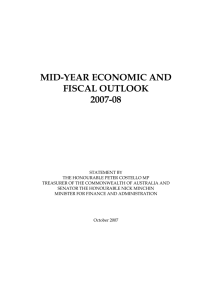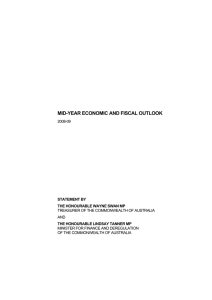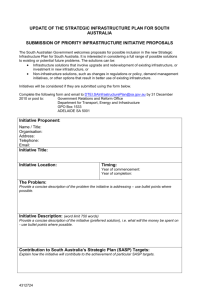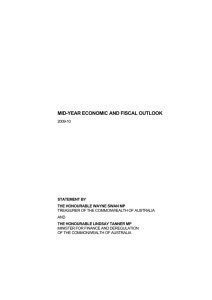2013-14 Budget Paper 3: 1.2 Global and National
advertisement
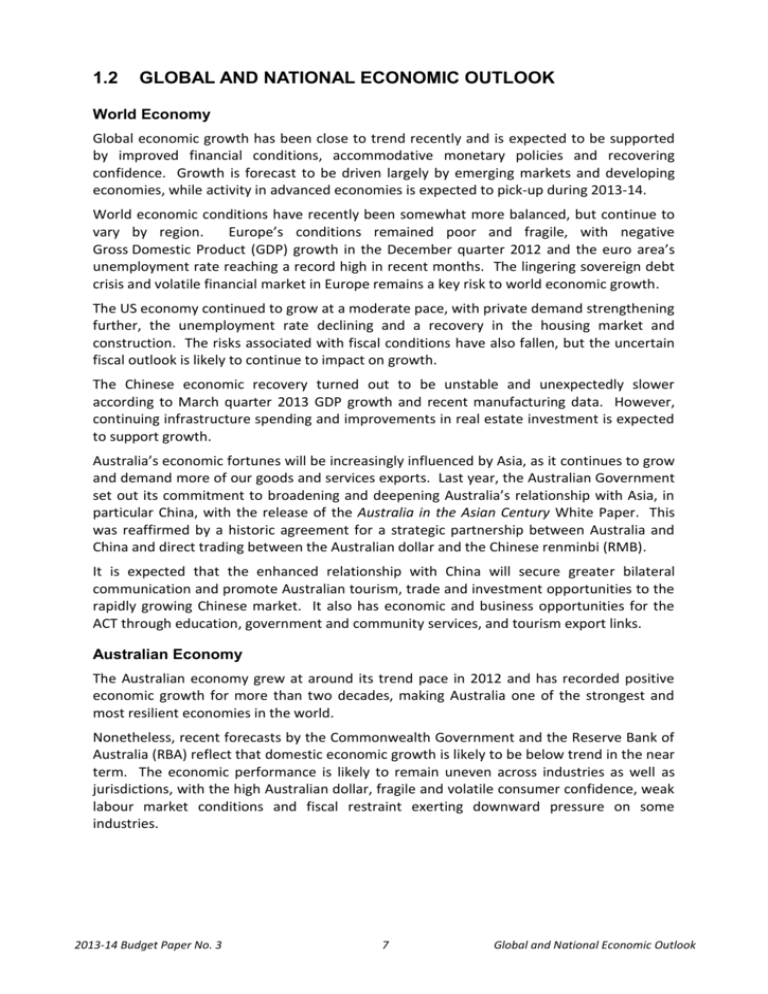
1.2 GLOBAL AND NATIONAL ECONOMIC OUTLOOK World Economy Global economic growth has been close to trend recently and is expected to be supported by improved financial conditions, accommodative monetary policies and recovering confidence. Growth is forecast to be driven largely by emerging markets and developing economies, while activity in advanced economies is expected to pick-up during 2013-14. World economic conditions have recently been somewhat more balanced, but continue to vary by region. Europe’s conditions remained poor and fragile, with negative Gross Domestic Product (GDP) growth in the December quarter 2012 and the euro area’s unemployment rate reaching a record high in recent months. The lingering sovereign debt crisis and volatile financial market in Europe remains a key risk to world economic growth. The US economy continued to grow at a moderate pace, with private demand strengthening further, the unemployment rate declining and a recovery in the housing market and construction. The risks associated with fiscal conditions have also fallen, but the uncertain fiscal outlook is likely to continue to impact on growth. The Chinese economic recovery turned out to be unstable and unexpectedly slower according to March quarter 2013 GDP growth and recent manufacturing data. However, continuing infrastructure spending and improvements in real estate investment is expected to support growth. Australia’s economic fortunes will be increasingly influenced by Asia, as it continues to grow and demand more of our goods and services exports. Last year, the Australian Government set out its commitment to broadening and deepening Australia’s relationship with Asia, in particular China, with the release of the Australia in the Asian Century White Paper. This was reaffirmed by a historic agreement for a strategic partnership between Australia and China and direct trading between the Australian dollar and the Chinese renminbi (RMB). It is expected that the enhanced relationship with China will secure greater bilateral communication and promote Australian tourism, trade and investment opportunities to the rapidly growing Chinese market. It also has economic and business opportunities for the ACT through education, government and community services, and tourism export links. Australian Economy The Australian economy grew at around its trend pace in 2012 and has recorded positive economic growth for more than two decades, making Australia one of the strongest and most resilient economies in the world. Nonetheless, recent forecasts by the Commonwealth Government and the Reserve Bank of Australia (RBA) reflect that domestic economic growth is likely to be below trend in the near term. The economic performance is likely to remain uneven across industries as well as jurisdictions, with the high Australian dollar, fragile and volatile consumer confidence, weak labour market conditions and fiscal restraint exerting downward pressure on some industries. 2013-14 Budget Paper No. 3 7 Global and National Economic Outlook The national economic outlook centres on the extent to which the resources sector will remain a key driver of economic growth in Australia. Mining investment in the pipeline remains strong and the completion of investment projects is expected to add to export volumes for resources. In the meantime, non-mining investment remains subdued despite low interest rates, raising concerns whether there will be enough momentum to offset the impact of slowing growth in the resources sector. Fiscal restraint from the Commonwealth and State governments are weighing on public consumption and are expected to persist in the near term given the ongoing pressures on taxation revenue collections. Household spending is likely to increase at the rate of income growth, underpinned by low interest rates, solid population growth and improved household net worth. The relatively high household saving ratio, however, still indicates that households are cautious and prudently managing their funds. National business surveys indicate labour demand in the mining sector eased further recently as a result of weaker commodity demand and a focus on minimising costs, while ongoing Commonwealth and State government fiscal consolidation have impacted public sector employment. As such, Commonwealth Government and RBA forecasts show that employment growth is expected to be modest, with the unemployment rate drifting slightly higher. Given the softer outlook for labour demand, wages growth is expected to be well contained. Weaker domestic demand and a high Australian dollar is expected to keep inflationary pressures contained in 2013-14. The RBA has cut the official cash rate by a cumulative 200 basis points since the end of 2011 to 2.75 per cent in May 2013. Lower interest rates in the short term will support interest-sensitive components of the economy such as business investment, household spending and thus broader economic growth in the ACT and nationally. As has been the practice, the 2013-14 ACT Budget forecasts assume that interest rates in 2012-13 and 2013-14 will move broadly in line with market expectations. 2013-14 Budget Paper No. 3 8 Global and National Economic Outlook




